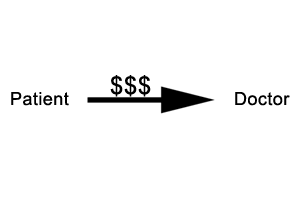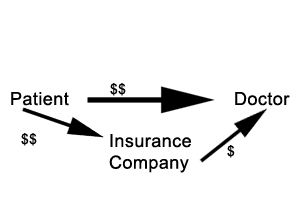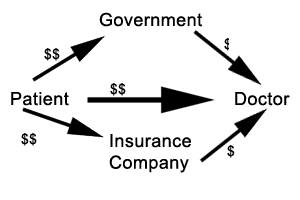Reality of Economy
Posted Sep 15, 2012Lets look at the basics of a monetary economy. Consider this article as "Economy 101".
First, what's money? Money is simply a medium for simpler exchange of goods and services.
Example without money:
Person #1: "Hi, I'd like to take that bed you made. I'll offer you these fifty pizzas I made today."
Person #2: "I don't need fifty pizzas. But if you have 80 pounds of pepperoni. I could trade that for something else I need."
Person #1: "OK, Deal. (Now what am I going to do with all these pizzas?)"
Example with money:
Person #1: "Hi, I'd like to take that bed you made. I'll offer you $500."
Person #2: "Sorry I need $600 to sell it."
Person #1: "OK, Deal."
Money really is that simple. However, the facts of using it are what gets a lot of people confused. Let's talk about the issue of profit and loss.
Pretend you are a manufacturer of glass drinking cups. After factoring in all labor, equipment, electricity, etc., It costs you $2.00 to produce each cup. You currently have $1 million dollars in the bank. If you sell each cup for $1.50 each, you lose 50 cents for each cup you make.
That means you can only make 2 million cups before you have lost all the money in the bank. You have no more money to pay employees, the electricity bill, etc. You are broke. Your company has to shut down. No more glass drinking cups. But hey, 2 million customers have great cups.
You could try to sell the cups for exactly what your costs are, $2.00 each. That way, everything stays steady, and you can continue to make a new cup for each one that's sold.
Eventually the cost of the silica sand you buy goes up. That's ok, because you can simply recalculate your new production costs and raise the price to cover it. Same with raising labor costs (as in giving the employees raises, requiring the cost per product to increase.)
However one day, a transport belt in the plant breaks down, costing $8,000 to repair. That's ok, you still have money in the bank. But little by little, more equipment needs to be replaced, using up the reserves in the bank. Remember, you are selling at the exact cost to produce, so there's no way to replenish lost reserves.
Then one day all the money in the bank is gone, and an important piece of equipment breaks down. Maybe you can get a loan to buy the new item you need, but you have to raise prices again to cover the loan.
All this keeps going and then one day, since you only sold at cost, you've run out of money and are out of options. The company must be closed again.
OK, this time you decide to sell at a huge profit. But you find that customers don't want to pay $500 per drinking glass, even though yours are the best in the world. It's simply too expensive and they don't sell. So in order to sell, you have to drop your price. But you learned your lesson about making sure you keep reserve cash in stock, so your new price is somewhere between $2.01 and $500.00 per glass. Clearly a wide margin, but you get the idea.
Well $2.01 is technically a profit, but making only $1 extra for every 100 glasses sold simply isn't enough to cover those problems we mentioned above.
Eventually you find a happy price structure that allows you to make sure you have enough money to cover unexpected expenses, expected equipment upgrades, etc. Congratulations. Your customers are happy. Your employees keep their jobs, you make good money, and most problems can be covered. In short, you're making a profit.
That is, until someone comes along that can make cups just as good, but for only $0.75 each and sells them for only $1.99 each. Now you're screwed and need to either readjust or close your shop and find some new line of work for yourself. Well, maybe not. Fact is, no industry lives on just one company alone. There's plenty of customers to cover both you and your new competition. However, you are now forced to adjust your retail price, spend more on marketing (now that you aren't the only choice in town, you must spend more to get folks to choose you.) and change other things. But your competition makes change too, and now you are battling for customers in order to stay in business. Welcome to the business world.
Distribution
We've talked about the cost of making and selling an item. A simple process. However the truth is, things often get much more complicated.
Now pretend you are running a chocolate bar making company. You are located in Cloverport, Kentucky. Your bars cost $0.05 to make and sell directly for $0.75.
Question: How do you sell to customers in Japan? You can't expect customers to fly a plane over and drive to your manufacturing plant just for a few candy bars.
So you find a retail company in Japan that's willing to put the bars on their shelves and sell to their customers. However, for this service, you can't expect them to do this for free. They need to make profit too. So you negotiate a lower price of $0.50 for them. They sell at $0.99 and keep the difference ($0.49 per bar sold) to cover their own costs.
But you still have the same problem. You need a way to transport your bars over to Japan to begin with. So you find a transportation company willing and able to move your products to Japan. Of course they require payment for their services too (boats/trucks/employees to pay for, etc.) The cost of shipment works out to an extra $0.07 per bar. So for this distribution channel, you are now paying $0.12 per bar to make and ship, and selling them for $0.49 to the retail store. It's less then the direct-to-consumer profit you had before, but you can reach much more potential customers. In the end you can now make and sell more than ever.
And that's the basics of distribution: The more hands involved in a distribution channel, the higher the cost in the end.
Here's a basic manufacturer-to-consumer distribution model:
Manufacturer
make 1,000,000 items
Sells 250,000 items @ $0.20 each to 4 different
|
V
Wholesalers
who sells in batches of 10,000 (upping the price to $0.30 each) to different
|
V
Jobbers
who sell 1,000 each (at $0.50 each) to multiple
|
V
Retail stores
who place them on their shelves to sell them for $1.00 to
|
V
Consumer
who uses the item they bought
Each person in a distribution chain must get paid for their services. They can't simply do their work every day for free.
But now a retail store contacts one of the wholesalers, and negotiates a deal that skips the jobber, in exchange for buying a much bigger quantity. The retailer gets the item for cheaper and can sell for less than their competing retail store.
A smaller distribution channel usually means lower final cost to the consumer.
Now that was a fairly simple distribution channel. Of course, things can get complicated, but generally, the same rules apply: More hands = higher cost.
Imagine you are selling something, but find that all your customers want to split the purchase among 10 different people, each paying 10% of the bill.
Now instead of a straight forward transaction, you must factor in the added costs of multiple payments: Extra time the salesmen, secretaries, accountants, etc. have to spend on tracking and handling 10X the transactions for moving one product. And time is money: An accountant that can handle 200 transactions/day adds $X/item to the cost, (his daily pay divided by 200) but now he can only handle 20 per day. Thus the cost is up, profit is down. If profit is too low, prices must rise. All because of this blasted multiple payment system.
Now let's use this knowledge to better understand a controversial service system currently used in the USA (and other places): The service of healthcare, meaning a doctor and patient.
At it's simplest form, it is a very basic transaction.

The doctor offers their services and you pay them. Simple.
However, now let's add the concept of insurance companies.
Health insurance confuses people but it's fairly simple: Getting money from 100 people to pay for the health care of one person, thus making it 100 times cheaper. Well, except for some important details:
- Those other 99 people expect to get something for their payment too
- The insurance company needs to profit as well
So the insurance company has to offer a benefit to those others, and what they are selling is lower health care costs. But the insurance company needs to get paid for their work, as does the doctor. So to hide the health care costs, it must be distributed among even more people.
Well, there isn't an infinite number of insurance customers to spread the costs among (and even if there were, it still wouldn't make things cheaper overall). So the formula they use to figure cost of goods/services goes like this:
(Expected total insurance cost of health care among (customer group) over the next 10 years + desired profit)/120 months = price/month
In other words, the insurance company tries to anticipate their costs for your health care over the next few years, (based on certain lifestyle information they have, which helps them place you into a "category", ranging from low to high risk) and charge you that amount plus extra.
So it looks sort of like this:

No matter how you look at it, the fact is: Insurance companies become an added part of the health care distribution channel. and what happens when the distribution channel gets bigger?
Right. Prices go up. The prices get spread out over a period of time, but in the end, you pay more than if you had to pay in one lump sum.
Don't believe me? Go to the doctor and tell them you have no health insurance. Guess what? They will likely offer you a "non-insurance discount". Meaning since they won't get a payment from the insurance company they need all the money from you. And one less distribution hassle means they can lower the overall price.
With the addition of health insurance, there are other factors (I.E. changes in customer behavior, partially because they are mistaken about "free" health care) that keep overall health cost rising much faster than they normally should. After all, spreading the costs among multiple people only works if those others don't also find a way to get their money's worth. But since they are paying for it, they use it. And the more they pay for it, the more likely they are to use it. A cycle of usage vs spreading the costs occurs. Prices go up. So folks raise a big stink, and now the government gets involved.
But since government officials misunderstand the true reasons for rising costs (or worse, fully understand but have ulterior motives then simply making the general public happy) they try to do the same thing the insurance companies do: Spread the cost over more people. Now we have something that looks like this.

Notice a few things in each of these pics:
- The lines of monetary distribution get more complicated
- The overall cost to the consumer gets bigger, just spread over more payment channels
So the answer to rising health care costs in a monetary economy is simple: Simplify the cost distribution. Remove government and health insurance as much as possible, instead of trying to integrate them more.
This is a basic view of basic economy. If you ever have questions about a companies motives, or why they can't do action X for "the good of the people" go back to these basics truths. Perhaps you can come up with a way to improve something in a way that can last (meaning, not go broke) and improve everyone's life.